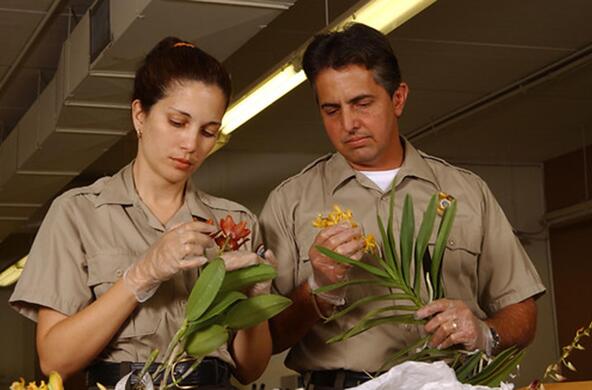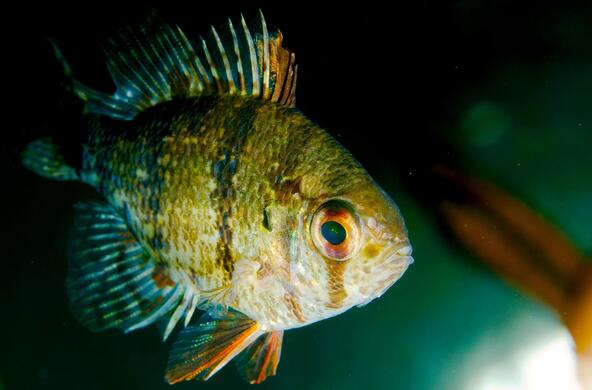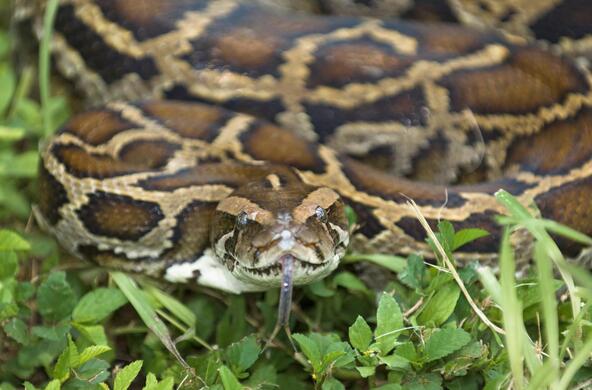Recently Joyce deVries Tomaselli touched a water chestnut plant.
"They're nasty. They've got these really sharp spikes," said Tomaselli, community horticulture educator and leader of the master garden program at Cornell Cooperative Extension Dutchess County in Millbrook.
As it turns out, the plant, which can be found along shore areas of the Hudson River, is an invasive species in New York. That is, it's a non-native plant that grows aggressively and causes harm, in this case, pain when touched and the forced crowding-out of native plants.
Likewise, Dave Strayer, a freshwater ecologist at the Cary Institute of Ecosystem Studies in Millbrook, said invasive species typically are referred to as those moved from their native range by human activity and, having established themselves in the wilds of the new place, cause ecological or economic harm. Related terms include: Introduced species, exotic species, non-native species, alien species and non-indigenous species.
"Human activities that move these species around include both deliberate introductions of species once thought to be beneficial but which later turned out to be harmful — like the common carp," said Strayer, "or accidental movement of species, as in ballast water or packing materials — like the emerald ash borer."
Laws govern invasive species, said Strayer, with the U.S. government defining invasives as an alien species whose introduction does or is likely to cause economic or environmental harm or harm to human health. In New York State, invasives are classified as non-native species to the ecosystem that are under consideration and likely to cause harm to the economy, environment or human health.
"They are a problem because a significant minority of the non-native species damage ecosystems, our economy and human health," said Strayer of invasives.
Tomaselli said the more people understand about invasive species, said the better actions will result.
"Once you identify what a specific plant or insect is, normally there are recommendations we can give on management or control," she said, such as pulling up, trimming, mowing or otherwise handling the invasive species.
This week marks New York State's first Invasive Species Awareness Week, July 6 through 12. The event, which is funded through the New York State Department of Environmental Conservation, is focused on raising awareness about invasives and helping stop their spread by engaging people in related activities.
Linda Rohleder of the New York-New Jersey Trail Conference is coordinator of the Lower Hudson Partnerships for Regional Invasive Species Management, one of eight regional groups across the state organizing Ivasive Species Awareness Week activities through local organizations, events and individuals.
"I think New York State as a whole has been ramping up its invasive species effort," said Rohleder, including a more active leadership of the issue.
Rohleder said in our region, which includes the counties of New York, Bronx, Rockland, Westchester, Putnam, Orange, Dutchess and lower Ulster, efforts are centered on encouraging adults and children to look, learn and lend a hand, from things such as reporting on invasive species to removing invasive plants and educating others.
"I think economic problems really get the most attention, but some of the more serious damage that slips beneath our noses is the environmental, the ecological damage," she said, for instance, long-lasting changes in nature's nutrient cycle per invasive activity, even after an invasive species is removed.
Strayer said some examples of invasive species include the zebra mussel, kudzu, gypsy moths, pythons in the Everglades, the Irish potato blight, smallpox and now chikungunya, Dutch elm disease, chestnut blight, emerald ash borer and many others.
"There aren't good, credible comprehensive assessments of the total amount of damage caused by invasive species, but the most widely quoted estimate … is that these species cost the U.S. economy more than $100 billion (per) year," he said, "about the same as the Iraq war at its peak, or about $1 per day for every person in the U.S."
While it's difficult to determine exactly how common invasive species are, he said in the U.S. increases continue to its more than 4,000 non-native species, that is, those not naturally found here, whether they're seen as harmful, desirable or neutral.
"In the fresh waters of the Hudson (River) and its watershed, there are more than 100 non-native species, with six to seven new species establishing each decade," Strayer said. "Studies in Europe and China have come up with comparable numbers, so this is a global problem, not an American one."
Some invasive species spread quickly because of fewer enemies in the new range. While all invasives are hardest to control after becoming well established, steps can be taken to control or reduce their effects through screened biologic controls, cutting and herbicides. Other measures include improved controls involving ballast-water intake and outtake, plus better management of dangerous species in the pet and horticulture trades and improved public education about the dangers of releasing species into the wild, canal barriers.
And, when possible, quickly ridding an area of new invaders can help avoid future problems, as when, said Strayer, a snakehead population in a lake in Orange County was eradicated by the DEC a few years ago.
"Perhaps the lowest-hanging fruit is better control of the movement of species before they arrive and establish themselves," he said.





